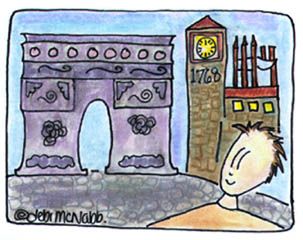- Home
- Programs
- International CyberFair
- Program Categories
- 6: Historical Landmarks
Category 6: Historical Landmarks
 |
Design a website and/or create a video story that documents and showcases historical landmarks (e.g. Missions, battle fields, architecture, cemeteries, street names).
The theme for
CyberFair 2026 is CONTRIBUTE & Unite!
Every contribution counts. Even small contributions can lead to great things. So,
let's CONTRIBUTE and unite to protect our communities, our environment,
our culture, our health, our animals, and our future.
“As we work to create light for others, we naturally light our
own way.” ~Mary Anne Radmacher
“When one gives, two get happy.” ~ Amit Kalantri
B: Learning Objectives:
- Students' views of the world community will be broadened through familiarity with the local community by an understanding of the concepts of continuity and change.
- Students will be able to relate the special historical landmarks that distinguish their community from other communities.
C: Discussion Questions:
- Is there a mission or other historical site in your community?
- Are there any well-known architects or famous buildings around?
- How were the streets in your community named?
- Are there any places especially interesting to students?
D. Suggested Starter Activities:
- View past projects produced by students in this category.
- Investigate the special geographical features that are land marks in your community. Describe how these features have impacted your area.
- Compare the historical landmarks in your community to those in a neighboring community.
- Students, individually or in small groups, choose a landmark to represent in an artistic manner: collage, drawing, mural etc. an d present their creation to an appropriate representative of that museum, mission, or historical site.
- If there is an historical society in your community, invite a member to visit the classroom. Prepare interview questions.
- Determine which historical landmarks students are familiar with in their community, which ones they have personally visited, which ones they would like to visit and why.
- Distribute promotional brochures which students have obtained from various historical landmarks. Have students select the most effective ones and explain why those were chosen.
- Create their own archives of the community which can be updated by ensuing classes.
- Large maps of the area around the school and scale models of the community can provide spatial perspective of historical landmarks. Topographical maps can also be built in.
- Working in small groups students can tape oral history interviews, write up the information, collect artifacts and present their projects to the school library, local library or museum.
-
Dakota Conflict of 1862
Dakota Meadows Middle School
(Minnesota, USA, 1999)
- The Supreme Court of Singapore
The Chinese High School
(Singapore, Singapore, 1999)
-
The Colonial History of Northern
Virginia
George Marshall High School
(Virginia, USA, 1999)
-
Ex Navicula Navis
XIII Liceum Ogolnoksztalcace
(Lodz, Poland, 1999)
-
The Arch
Citta' dei Ragazzi
(Rome, Italy, 1998)
-
Our Community Weaves a Tapestry of Gold
Deer Creek School
(California, USA, 1998)
-
A Cyber Tour of Historic Flemington, New
Jersey
Copper Hill School
(New Jersey, USA, 1998)
-
Life at Sterkfontein
Adelaar High School
(Gauteng, South Africa, 1997)
-
Historical Landmarks of Escondido
L. R. Green School
(California, USA, 1997)
-
Wiscasset's Historical Landmarks
Wiscasset Primary School
(Maine, USA, 1997)
-
Venture into our Blackland Prairie
Alpha Omega Christian School of Leonard
(Texas, USA, 1997)
-
Roma - History and Civilization of the Eternal City
Città dei Ragazzi di Roma (Boys' Town of Rome)
(Rome, Italy, 1996)